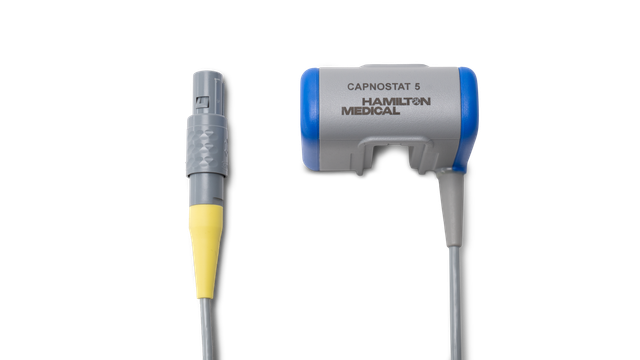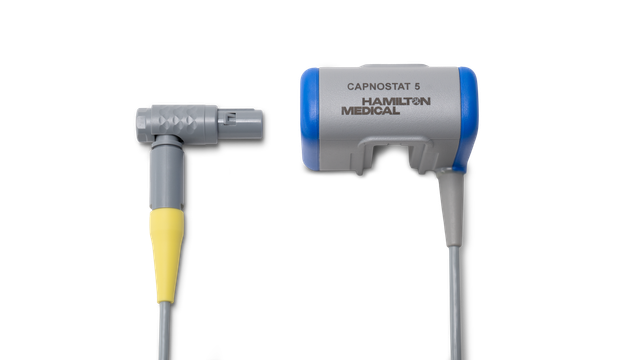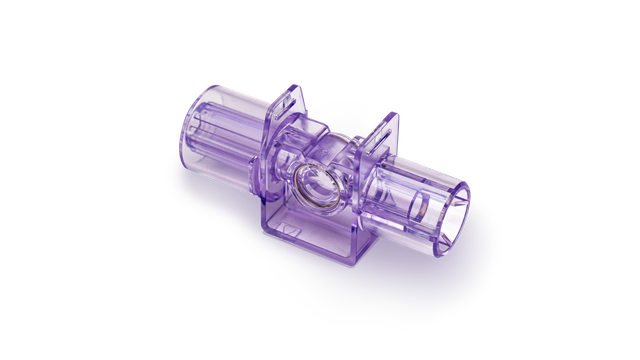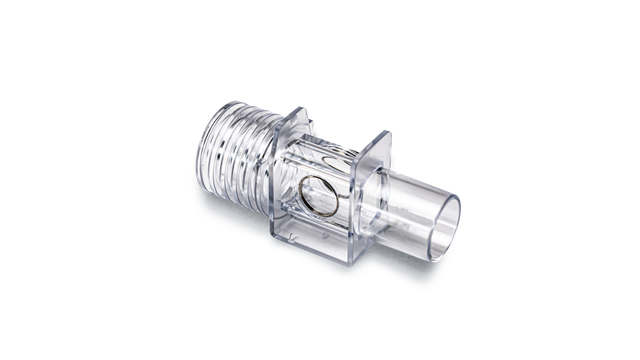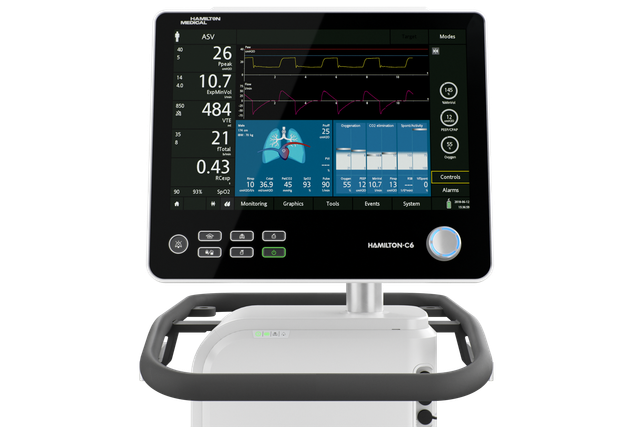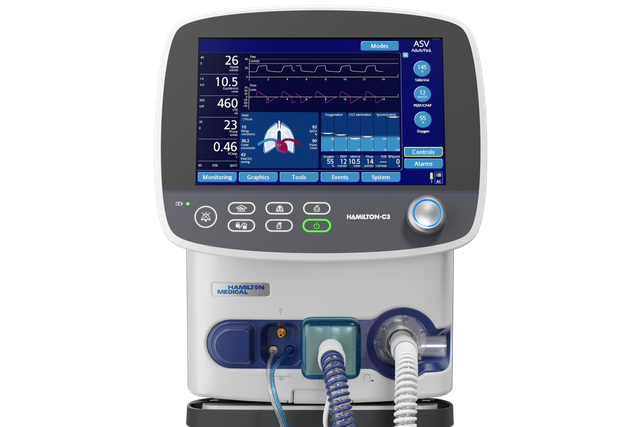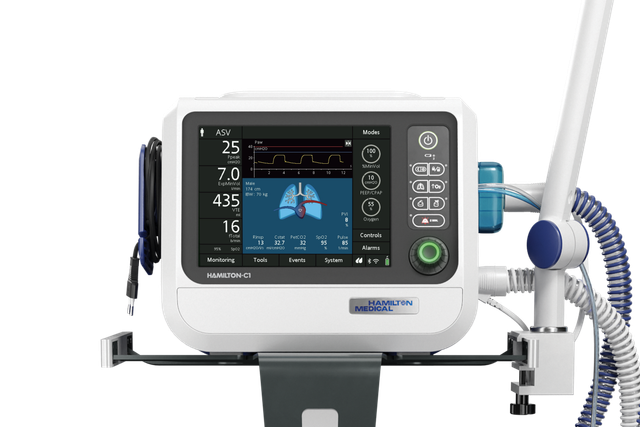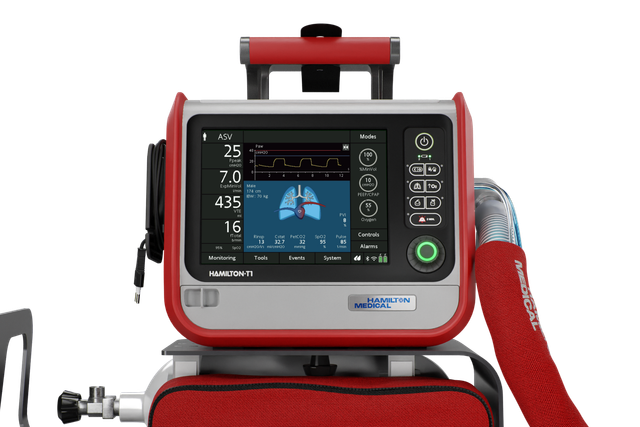
Дополнительные сведения. Волюметрический мониторинг концентрации CO2
Фазы волюметрической капнограммы, форма и морфология кривой, а также измерения, основанные на ее расчетах, могут дать следующую важную информацию:
- об эффективности вентиляции и перфузии;
- о физиологической объемной части мертвого пространства;
- о скорости метаболизма у пациента (
Jaffe MB. Using the features of the time and volumetric capnogram for classification and prediction. J Clin Monit Comput. 2017;31(1):19‑41. doi:10.1007/s10877‑016‑9830‑z1 )
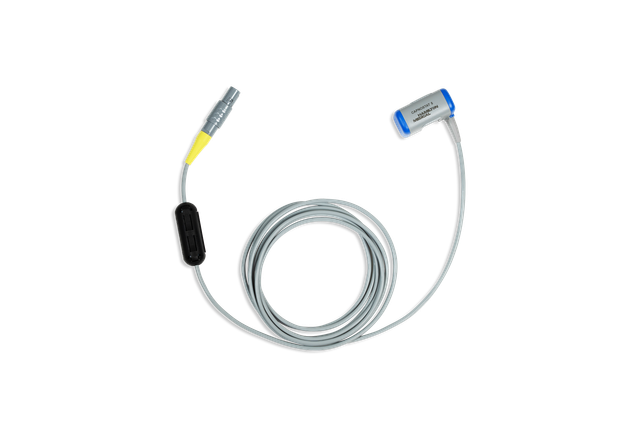
Мощный инструмент. Датчик CO2
В наших аппаратах ИВЛ концентрация CO2 измеряется с помощью СО2‑датчика для основного потока CAPNOSTAT‑5, который находится рядом с дыхательными путями пациента.
Датчик CAPNOSTAT‑5 обеспечивает точное измерение концентрации углекислого газа в конце выдоха (PetCO2), а также дает точную капнограмму при частоте дыхания до 150 дыхательных движений в минуту.
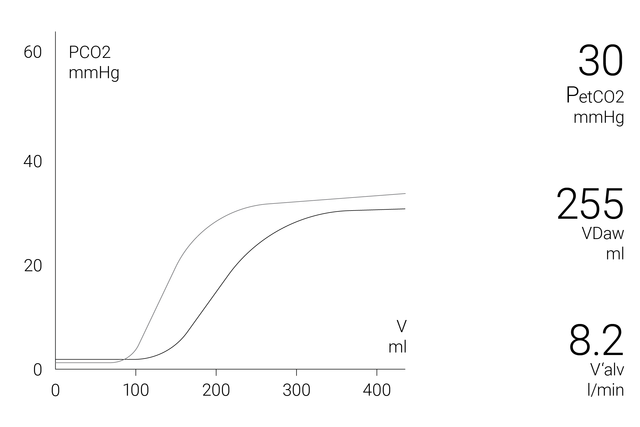
Маленький датчик, большой объем данных Информация, которую передает датчик
В окне волюметрической капнограммы на экране отображается точная количественная информация в виде комбинации данных проксимального потока и уровня CO2, таких как:
- текущая кривая волюметрической капнограммы;
- эталонная кривая волюметрической капнограммы;
- кнопка эталонной кривой со временем и датой референсной петли;
- наиболее актуальные значения CO2 для каждого вдоха.
Для более полного анализа состояния пациента в аппаратах ИВЛ предусмотрена функция определения трендов за 72 часа (в аппаратах ИВЛ HAMILTON‑G5/S1 ‑ за 96 часов) для следующих параметров:
- «PetCO2»;
- «V'CO2»;
- «FetCO2»;
- «VeCO2»;
- «ViCO2»;
- «Vtальв»;
- «V'альв»;
- «VDдп»;
- «VD/Vt»;
- «VDдп/VTE»;
- «НарастCO2»
Для удобства пользователя в аппаратах ИВЛ Hamilton Medical все значения, связанные с CO2, отображаются в окне «Мониторинг CO2».
- Парциальная концентрация CO2 в конце выдоха: FetCO2 (%)
- Давление CO2 в конце выдоха: PetCO2 (ммРт)
- Подъем альвеолярного плато на кривой значений «PetCO2», указывающий на показатели объема/потока в легких: нарастCO2 (%CO2/л)
- Альвеолярный дыхательный объем: Vtальв (мл)
- Альвеолярная минутная вентиляция: V'альв (л/мин)
- Выведение CO2: V'CO2 (мл/мин)
- Мертвое пространство дыхательных путей: VDдп (мл)
- Объемная часть мертвого пространства на входе в дыхательные пути: VDдп/VTE (%)
- Объем выдыхаемого CO2: VeCO2 (мл)
- Объем вдыхаемого CO2: ViCO2 (мл)
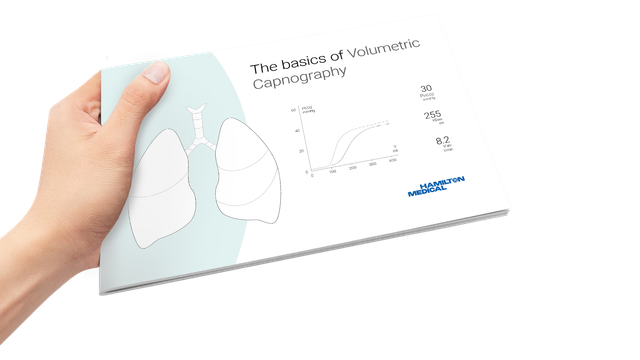
Бесплатная электронная книга
Полезно знать! Все о волюметрической капнографии
Узнайте, как читать волюметрические капнограммы, каковы их преимущества и где применять полученные данные. Книга также содержит тест для самопроверки.
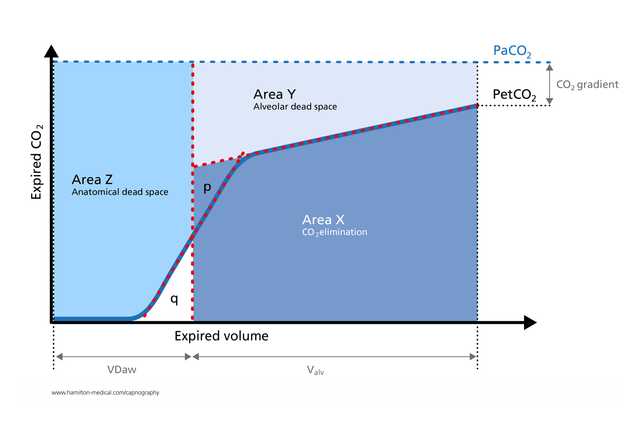
Каковы преимущества? Немного доказательств
Волюметрическая капнограмма успешно используется для измерения анатомического мертвого пространства, перфузии легочных капилляров и эффективности вентиляции (
Romero PV, Lucangelo U, Lopez Aguilar J, Fernandez R, Blanch L. Physiologically based indices of volumetric capnography in patients receiving mechanical ventilation. Eur Respir J. 1997;10(6):1309‑1315. doi:10.1183/09031936.97.100613092 )Расчеты, полученные с помощью волюметрической капнографии, используются для выявления легочной эмболии у постели больного (
Blanch L, Romero PV, Lucangelo U. Volumetric capnography in the mechanically ventilated patient. Minerva Anestesiol. 2006;72(6):577‑585. 3 )Исследование показало, что при волюметрической капнографии результаты измерения соотношения физиологической объемной части мертвого пространства и дыхательного объема у пациентов с ARDS, находящихся на искусственной вентиляции легких, отличаются такой же точностью, как и результаты, полученные методом метаболического мониторинга (
Kallet RH, Daniel BM, Garcia O, Matthay MA. Accuracy of physiologic dead space measurements in patients with acute respiratory distress syndrome using volumetric capnography: comparison with the metabolic monitor method. Respir Care. 2005;50(4):462‑467. 4 )Экспираторная капнограмма ‑ это быстрое неинвазивное измерение, не зависящее от дыхательного усилия, которое помогает выявить выраженный бронхоспазм у взрослых пациентов с астмой (
Yaron M, Padyk P, Hutsinpiller M, Cairns CB. Utility of the expiratory capnogram in the assessment of bronchospasm. Ann Emerg Med. 1996;28(4):403-407. doi:10.1016/s0196-0644(96)70005-75 )Волюметрическая капнография дает ценную информацию о физиологии коллапса легких и рекрутмента неинвазивным способом в реальном времени и таким образом позволяет контролировать цикличное выполнение маневров рекрутмента при лечении пациента (
Tusman G, Suarez‑Sipmann F, Böhm SH, et al. Monitoring dead space during recruitment and PEEP titration in an experimental model. Intensive Care Med. 2006;32(11):1863‑1871. doi:10.1007/s00134‑006‑0371‑76 )

Полезно знать! Материалы курса обучения по использованию волюметрической капнографии
Принадлежности и расходные материалы
Компания Hamilton Medical предлагает оригинальные расходные материалы для всех групп пациентов: взрослых, детей и младенцев. Доступны продукты для многократного или разового использования (выбор зависит от политики вашего учреждения).
Доступность
Волюметрическая капнография доступна как опция в аппаратах ИВЛ HAMILTON‑C6, HAMILTON‑G5, HAMILTON‑C3 и HAMILTON‑C1/T1, а также как стандартная функция в аппарате HAMILTON‑S1.
Дополнительные сведения
Volumetric capnography user guide
Использование функции трендов для параметра PetCO2
Basics of capnography
Список литературы
- 1. Jaffe MB. Using the features of the time and volumetric capnogram for classification and prediction. J Clin Monit Comput. 2017;31(1):19‑41. doi:10.1007/s10877‑016‑9830‑z
- 2. Romero PV, Lucangelo U, Lopez Aguilar J, Fernandez R, Blanch L. Physiologically based indices of volumetric capnography in patients receiving mechanical ventilation. Eur Respir J. 1997;10(6):1309‑1315. doi:10.1183/09031936.97.10061309
- 3. Blanch L, Romero PV, Lucangelo U. Volumetric capnography in the mechanically ventilated patient. Minerva Anestesiol. 2006;72(6):577‑585.
- 4. Kallet RH, Daniel BM, Garcia O, Matthay MA. Accuracy of physiologic dead space measurements in patients with acute respiratory distress syndrome using volumetric capnography: comparison with the metabolic monitor method. Respir Care. 2005;50(4):462‑467.
- 5. Yaron M, Padyk P, Hutsinpiller M, Cairns CB. Utility of the expiratory capnogram in the assessment of bronchospasm. Ann Emerg Med. 1996;28(4):403‑407. doi:10.1016/s0196‑0644(96)70005‑7
- 6. Tusman G, Suarez‑Sipmann F, Böhm SH, et al. Monitoring dead space during recruitment and PEEP titration in an experimental model. Intensive Care Med. 2006;32(11):1863‑1871. doi:10.1007/s00134‑006‑0371‑7


